| Listing 1 - 10 of 77 | << page >> |
Sort by
|
Book
Abstract | Keywords | Export | Availability | Bookmark
 Loading...
Loading...Choose an application
- Reference Manager
- EndNote
- RefWorks (Direct export to RefWorks)
Social geography --- Inner cities --- Central cities --- Ghettos, Inner city --- Inner city ghettos --- Inner city problems --- Zones of transitions --- Cities and towns --- Urban cores
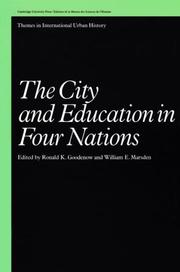
ISBN: 0521410843 Year: 1992 Publisher: Cambridge Cambridge University Press
Abstract | Keywords | Export | Availability | Bookmark
 Loading...
Loading...Choose an application
- Reference Manager
- EndNote
- RefWorks (Direct export to RefWorks)
Education, Urban --- -Education, Urban --- -Inner city education --- Urban education --- Cities and towns --- Urban policy --- History --- -History --- Inner city education
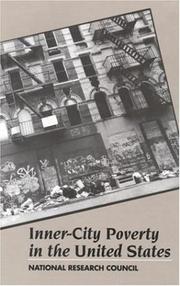
ISBN: 0309042798 9786610212378 1280212373 0309543495 0585144486 9780585144481 9780309042796 9781280212376 6610212376 9780309543491 Year: 1990 Publisher: Washington, D.C. : National Academy Press,
Abstract | Keywords | Export | Availability | Bookmark
 Loading...
Loading...Choose an application
- Reference Manager
- EndNote
- RefWorks (Direct export to RefWorks)
Documents the growth of concentrated poverty in central cities of the United States and examines what is known about its causes and effects. This volume is useful for policymakers, program administrators, researchers studying urban poverty issues, faculty, and students.
Urban poor --- Inner cities --- Government policy --- Central cities --- Ghettos, Inner city --- Inner city ghettos --- Inner city problems --- Zones of transitions --- Cities and towns --- Urban cores --- City dwellers --- Poor --- United States
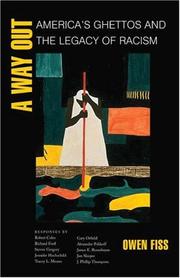
ISBN: 1282158074 9786612158070 1400825512 9781400825516 9780691088815 0691088810 0691088810 9781282158078 Year: 2003 Publisher: Princeton, N.J. : Princeton University Press,
Abstract | Keywords | Export | Availability | Bookmark
 Loading...
Loading...Choose an application
- Reference Manager
- EndNote
- RefWorks (Direct export to RefWorks)
After decades of hand-wringing and well-intentioned efforts to improve inner cities, ghettos remain places of degrading poverty with few jobs, much crime, failing schools, and dilapidated housing. Stepping around fruitless arguments over whether or not ghettos are dysfunctional communities that exacerbate poverty, and beyond modest proposals to ameliorate their problems, one of America's leading experts on civil rights gives us a stunning but commonsensical solution: give residents the means to leave. Inner cities, writes Owen Fiss, are structures of subordination. The only way to end the poverty they transmit across generations is to help people move out of them--and into neighborhoods with higher employment rates and decent schools. Based on programs tried successfully in Chicago and elsewhere, Fiss's proposal is for a provocative national policy initiative that would give inner-city residents rent vouchers so they can move to better neighborhoods. This would end at last the informal segregation, by race and income, of our metropolitan regions. Given the government's role in creating and maintaining segregation, Fiss argues, justice demands no less than such sweeping federal action. To sample the heated controversy that Fiss's ideas will ignite, the book includes ten responses from scholars, journalists, and practicing lawyers. Some endorse Fiss's proposal in general terms but take issue with particulars. Others concur with his diagnosis of the problem but argue that his policy response is wrongheaded. Still others accuse Fiss of underestimating the internal strength of inner-city communities as well as the hostility of white suburbs. Fiss's bold views should set off a debate that will help shape urban social policy into the foreseeable future. It is indispensable reading for anyone interested in social justice, domestic policy, or the fate of our cities.
Occupational mobility --- Urban poor --- Inner cities --- Social problems --- City dwellers --- Poor --- Central cities --- Ghettos, Inner city --- Inner city ghettos --- Inner city problems --- Zones of transitions --- Cities and towns --- Urban cores --- Government policy
Book
ISBN: 067497462X 0674974646 9780674974647 9780674970502 0674970500 9780674984073 0674984072 Year: 2017 Publisher: Cambridge, MA : Harvard University Press,
Abstract | Keywords | Export | Availability | Bookmark
 Loading...
Loading...Choose an application
- Reference Manager
- EndNote
- RefWorks (Direct export to RefWorks)
Why do American ghettos persist? Decades after Moynihan’s report on the black family and the Kerner Commission’s investigations of urban disorders, deeply disadvantaged black communities remain a disturbing reality. Scholars and commentators today often identify some factor—such as single motherhood, joblessness, or violent street crime—as the key to solving the problem and recommend policies accordingly. But, Tommie Shelby argues, these attempts to “fix” ghettos or “help” their poor inhabitants ignore fundamental questions of justice and fail to see the urban poor as moral agents responding to injustice. Drawing on liberal-egalitarian philosophy and informed by leading social science research, Dark Ghettos examines the thorny questions of political morality raised by ghettos. Should government foster integrated neighborhoods? If a “culture of poverty” exists, what interventions are justified? Should single parenthood be avoided or deterred? Is voluntary nonwork or crime an acceptable mode of dissent? How should a criminal justice system treat the oppressed? Shelby offers practical answers, framed in terms of what justice requires of both a government and its citizens, and he views the oppressed as allies in the fight for a society that warrants everyone’s allegiance. “The ghetto is not ‘their’ problem but ours, privileged and disadvantaged alike,” Shelby writes. The existence of ghettos is evidence that our society is marred by structural injustices that demand immediate rectification. Dark Ghettos advances a social vision and political ethics that calls for putting the abolition of ghettos at the center of reform.
Inner cities --- Social justice --- Racism in public welfare --- African Americans --- Central cities --- Ghettos, Inner city --- Inner city ghettos --- Inner city problems --- Zones of transitions --- Cities and towns --- Urban cores --- Welfare racism --- Public welfare --- Social conditions. --- Government policy
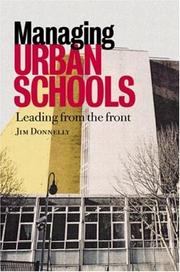
ISBN: 1138421200 1135725012 1280075090 020341683X 9780203416839 0749438681 Year: 2003 Publisher: London ; Sterling, VA : Kogan Page,
Abstract | Keywords | Export | Availability | Bookmark
 Loading...
Loading...Choose an application
- Reference Manager
- EndNote
- RefWorks (Direct export to RefWorks)
This work makes a contribution to the understanding of how urban and city schools need to operate and how they need to be led. Headteachers and Deputies, those studying for the NPQH, and all aspirant school leaders should find this text useful in.
Urban schools --- Education, Urban --- School management and organization --- Inner city education --- Urban education --- Cities and towns --- Urban policy --- Inner city schools --- City schools --- Schools --- Administration. --- Social aspects
Book
ISBN: 1617356379 9781617356377 9781617356360 1617356360 9781617356353 1617356352 Year: 2011 Publisher: Charlotte, N.C. : Information Age Pub., Inc.,
Abstract | Keywords | Export | Availability | Bookmark
 Loading...
Loading...Choose an application
- Reference Manager
- EndNote
- RefWorks (Direct export to RefWorks)
Plaintext description.
Urban schools --- Education, Urban --- Educational change --- School improvement programs --- Inner city schools --- City schools --- Schools
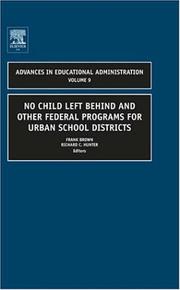
ISBN: 9781849504041 1849504040 0762312998 9786610642861 1280642866 0080461824 9780080461823 9780762312993 9780762312993 Year: 2009 Publisher: Bingley Emerald Group Publishing Limited
Abstract | Keywords | Export | Availability | Bookmark
 Loading...
Loading...Choose an application
- Reference Manager
- EndNote
- RefWorks (Direct export to RefWorks)
The No Child Left Behind (NCLB) Act is designed to close the achievement gap between disadvantaged and disadvantaged children through its Title I program. Title I provides disadvantaged students with compensatory education. Only Title I schools are required to meet NCLB accountability guidelines but some states apply federal accountability guidelines to non-Title I schools; and states must separate achievement test scores by racial subgroups. The book explores models to achieve equity in Title I schools. The authors define what is required of states in Title I schools. The NCLB guidelines are flexible: states may confine their accountability involvement to Title I schools only and limit the number of Title I schools in their state; states may establish their own standardized tests and establish their own racial subgroups. The authors examine how each state reacts and implements NCLB accountability standards, and challenges to these guidelines in the courts and in the body politics by states. The text examines the achievements of NCLB, and the implications of the Act. The text also reviews implications for a larger immigrant population that did not exist in 1965 when Title I was originally enacted by Congress; and the impact of globalization the educational needs of the country. It explores models to achieve equity under the No Child Left Behind (NCLB) Act.
Education, Urban --- Educational equalization --- Urban schools --- Education and state --- Inner city schools --- City schools --- Schools --- Inner city education --- Urban education --- Cities and towns --- Urban policy --- Government policy --- Administration. --- Schools. --- USA. --- Education --- Administration --- General.
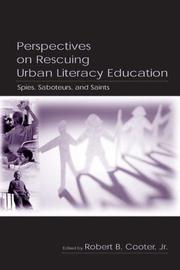
ISBN: 1410609472 9781410609472 9780805842906 080584290X 0805842896 080584290X 9780805842890 9781135632144 1135632146 9781135632182 1135632189 9781135632199 1135632197 Year: 2004 Publisher: Mahwah, N.J. : L. Erlbaum,
Abstract | Keywords | Export | Availability | Bookmark
 Loading...
Loading...Choose an application
- Reference Manager
- EndNote
- RefWorks (Direct export to RefWorks)
Perspectives on Rescuing Urban Literacy Education: Spies, Saboteurs, and Saints is an exploration of the variables that contribute to the improvement of literacy instruction in large urban school districts. The book grows out of a five-year initiative known as The Dallas Reading Plan--a 50 million collaborative effort between area business and corporate interests, philanthropy, and the Dallas Independent School District. Audiences include university professors and graduate students in reading/literacy education, educational leadership, special education, urban studies, and chan
Education, Urban --- Language arts --- Communication arts --- Communication --- Inner city education --- Urban education --- Cities and towns --- Urban policy --- Study and teaching
Book
ISBN: 0521277116 Year: 1989 Publisher: Cambridge Cambridge University Press
Abstract | Keywords | Export | Availability | Bookmark
 Loading...
Loading...Choose an application
- Reference Manager
- EndNote
- RefWorks (Direct export to RefWorks)
USA -- 930.32 --- IMMIGRANTEN -- 930.32 --- Immigrants --- Inner cities --- Slums --- Urban minorities --- Urban poor --- City dwellers --- Minorities --- Poor --- Slum clearance --- Housing --- Central cities --- Ghettos, Inner city --- Inner city ghettos --- Inner city problems --- Zones of transitions --- Cities and towns --- Urban cores --- History --- United States --- Social conditions
| Listing 1 - 10 of 77 | << page >> |
Sort by
|

 Search
Search Feedback
Feedback About UniCat
About UniCat  Help
Help News
News